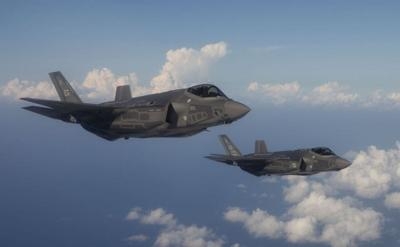Wed, May 17, 2017
Lower Weight Limit Of 136 Pounds Removed After Modifications
Air Force leaders recently removed the restriction that kept pilots weighing less than 136 pounds from flying the F-35A. The restriction was imposed in 2015 due to concerns about the risk during ejections in a portion of the flight envelope.

After rigorous testing to ensure the escape system works reliably and safely in all planned conditions and across all pilot weights, three distinct modifications were implemented. A switch was installed on the seat that slightly delays parachute deployment at high speeds and decreases parachute opening forces for lightweight pilots. Additionally, a head support panel has been mounted on the rear risers of the parachute to prevent the pilot’s head from moving backwards during an ejection. Finally, the overall helmet weight has been reduced through both the reduction of internal strapping material and the removal of an additional external visor, which decreases injury risk during parachute opening.
“I have personally briefed every single F-35 pilot in the United States Air Force about these changes to their ejection seat, and I’m confident our pilots are no longer concerned with the safety of the F-35 ejection system. I've flown in this seat myself and believe, with these modifications, this is the safest ejection seat I've ever flown,” said Brig. Gen. Scott L. Pleus, the F-35 Integration Office director.
In July 2015, during the manufacturer’s ongoing testing, analysis identified an unacceptable risk of neck injury during parachute deployment/opening for pilots weighing less than 136 pounds. The requirement is for the seat to be certified for any pilot weighing between 103 and 245 pounds.
Air Force headquarters and wing leadership took immediate action to ensure pilot safety and work with the manufacturer to meet requirements for the seat. The F-35 Joint Program Office has been working in concert with contractors to develop options to reconfigure the ejection system.
The new ejection seats are already being retrofitted into the existing fleet, and the lightweight helmets are available in pre-production now, while full production starts later this year. The Air Force has received more than 100 F-35As to date, trained more than 400 pilots and accumulated more than 40,000 flight hours.
(Source: USAF news release. Image from file)
More News
Also: Vertical Flight Society, NBAA Maintenance Conference, GA Honored, AMT Scholarship For the first time, students from Embry-Riddle’s Daytona Beach, Florida, campus took t>[...]
Hazardous Weather Information Summary of significant meteorological information (SIGMET/WS), convective significant meteorological information (convective SIGMET/WST), urgent pilot>[...]
"The need for innovation at speed and scale is greater than ever. The X-62A VISTA is a crucial platform in our efforts to develop, test and integrate AI, as well as to establish AI>[...]
(FAA) Inspector Observed That Both Fuel Tanks Were Intact And That Only A Minimal Amount Of Fuel Remained In Each Analysis: According to the pilot, approximately 8 miles from the d>[...]
“Pyka’s Pelican Cargo is unlike any other UAS solution on the market for contested logistics. We assessed a number of leading capabilities and concluded that the Pelica>[...]
 Airborne-Flight Training 05.09.24: ERAU at AIAA, LIFT Diamond Buy, Epic A&P
Airborne-Flight Training 05.09.24: ERAU at AIAA, LIFT Diamond Buy, Epic A&P ANN's Daily Aero-Term (05.07.24): Hazardous Weather Information
ANN's Daily Aero-Term (05.07.24): Hazardous Weather Information Aero-News: Quote of the Day (05.07.24)
Aero-News: Quote of the Day (05.07.24) NTSB Final Report: Cessna 150
NTSB Final Report: Cessna 150 Aero-News: Quote of the Day (05.08.24)
Aero-News: Quote of the Day (05.08.24)



